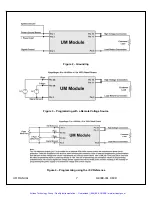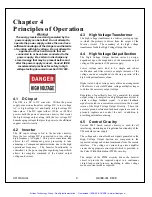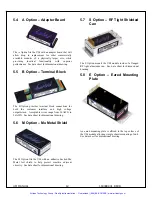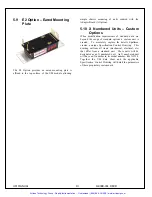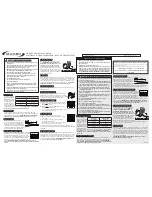
UM MANUAL
9
118098-001 REV B
Chapter 4
Principles of Operation
Warning!
The energy levels used and generated by the
power supply can be lethal! Do not attempt to
operate the power supply unless the user has a
sufficient knowledge of the dangers and hazards
of working with high voltage. Do not attempt to
approach or touch and circuits that are
connected to or have been connected to the
power supply. Be certain to discharge any
stored energy that may be present before and
after the power supply is used. Consult IEEE
recommended practices for safety in high
voltage testing document number 510-1983.
4.1 DC
Input
The UM is a DC to DC converter. Within the power
supply conversions from low voltage DC, to low voltage
AC, to high voltage AC and finally to high voltage DC
takes place. The DC input (12Vdc or +24Vdc)
powers both the power conversion circuitry that creates
the high voltage output, along with the low voltage DC
housekeeping voltages that provide power to the affiliated
support control circuitry.
4.2 Inverter
The DC input voltage is fed to the Inverter circuitry.
Here the low voltage DC is converted to a low voltage,
high frequency AC signal. This power conversion step
allows for all subsequent power processing to take
advantage of component miniaturization due to the high
operational frequency. The Inverter functionality is
controlled via the power supplies regulating loops which
allows for complete command of the desired output
voltage and current.
4.3 High Voltage Transformer
The high voltage transformer is a ferrite core step up type
in which the primary is driven from the output of the
Inverter circuit. The secondary of the high voltage
transformer feeds the High Voltage Output Section.
4.4 High Voltage Output Section
The High Voltage Output Section varies by design,
dependent upon the magnitude of the maximum output
voltage of the particular UM power supply.
Lower voltage units tend to be simple and robust
rectification and filter circuits as ample increase of the
voltage can be accomplished via the step up ratio of the
high voltage transformer alone.
Higher rated output voltage units utilize an arrangement
of half wave Cockcroft-Walton voltage multiplier stages
to obtain the necessary output voltage.
Regardless of specifically how it’s generated, the actual
output voltage is sampled via a high impedance divider to
create a voltage feedback signal. A current feedback
signal is created via a current sense resistor in the low end
return of the High Voltage Output Circuitry. These two
accurate ground referenced feedback signals are used to
precisely regulate and control the unit, in addition to
providing external monitoring.
4.5 Control
Circuitry
Various SMT based control circuitry is used for all
interfacing, monitoring and regulation functionality of the
UM modular power supply.
The voltage and current feedback signals generated in the
High Voltage Output Section are compared to the
requested voltage and current commands from the remote
interface. The voltage or current loop error amplifier
creates the appropriate error signal which is provided to
the Pulse Width Modulation (PWM) circuitry.
The output of the PWM circuitry drives the Inverter
circuit to provide the required output in a continuous
closed loop control process, regulating in either voltage
mode or current mode as required.
Artisan Technology Group - Quality Instrumentation ... Guaranteed | (888) 88-SOURCE | www.artisantg.com













